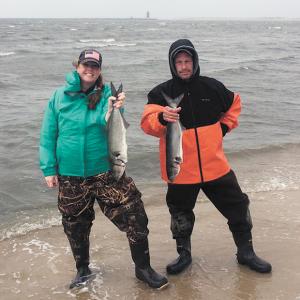We have been having a blast with spring-like weather in winter and winter-like weather in spring. Seriously, you have missed a roller coaster of crazy weather, but you can still get in on the roller coaster of wild fishing. The big gator bluefish are back in town and the action is as heavy as it was when this first happened three years ago. We haven’t seen bluefish like this in the surf in over forty years. I remember this action happening when I was young, really young. Now every year these yellow-eyed devils make an appearance and the action is insane.
The Cape Henlopen pier has been on fire since the bluefish showed up; it will slow down a little then blow up the next day. The first few days the blues showed up we went down there and I bailed out eleven fish in forty-five minutes. It was a great day of catching and the new DSF signature series surf rod got the job done. All I had to do was cast and reel, the rod did all of the work. Patrick Conroy at PC Rods in Milton built a beast of a surf rod for Delaware Surf Fishing; I now have the best rod for surfcasting. While we were bailing fish one after another, the action was on fire from North Carolina to New Jersey. There will still be plenty of time to catch these bluefish; they are still in North Carolina. How long that action will last I cannot even begin to guess. The first year they showed up we were catching them until the second week of June. The water temperatures have been perfect and the cooler weather is helping keep them in the lower sixties. Expect this next week to bounce the temperatures up a good eight degrees into the upper sixties, especially in the back bays. I am sure the inland bays will hit the low seventies.
Now what do you need to catch these gator bluefish? Spoons have been my favorite, and top water plugs. Now that the fish have schooled up they are feeding more aggressively, so you will need steel leaders. We are also using mullet on Diamond State Custom Tackle surf rigs. The heavy hundred-and-fifty-pound mono leader works just fine for the bluefish, so you don’t always need steel leaders. In a pinch I will use heavy monofilament to make leaders for my spoons and plugs. Make sure you have dark swivels and not shiny ones. The competing bluefish will hit the swivel and cut your line. It attracts a strike every time. Surf anglers are losing a lot of gear to cut lines from blues in schools on a feeding frenzy. It is best to keep your gear close to shore, make that cast short. Fish the inside of the school so you don’t have to try and drag a fish out of the far side of the school, you will get cut off almost every time.
Aside from bluefish, there are plenty of other fish out there right now. Flounder have been hitting well in the Lewes Canal and Indian River Inlet. Drifting minnows or using Gulp on a bucktail or jig head. Even using Gulp on a flounder rig and drifting. A few have been caught in the surf jigging the cuts, they are in close eating baitfish and sand fleas. They will hit mullet rigs on the retrieve when you are checking your bait. They are usually in close to the shorebreak feeding along that edge of sand.
Kingfish and northern puffers showed up a few weeks ago, hitting bloodworms on top and bottom rigs in the surf. Problem has been fishing for them when all of those bluefish are in the vicinity. Once the bluefish show up change your techniques or move. Short striped bass are being caught in the surf, a couple of weeks ago before the blues showed up they were the hot catch, hitting jigs, bucktails, soft plastic swim shads, and spoons. The outgoing to the incoming tide transition was some of the best action. That is usually a four-hour window, which many of us prefer to fish. Keeper migratory bass just started showing up in the surf and Indian River Inlet. The action has been random, and Assateague Island is producing some nice catches. The post spawn bass are still in the Chesapeake Bay so there is plenty of time for catching migratory striped bass. It just all depends on if they come close to shore on their way north, and if you can get away from the bluefish. Look for striped bass (rockfish) behind and under bluefish schools. That is the hard part! The yellow eyed devils are vicious feeders.
Black drum have come in strong this spring. Delaware Bay beaches and the coral beds in the bay have seen decent drum action. Assateague Island has as well, even the ocean-side beaches at Cape Henlopen State park. Clam is usually the best bait for these behemoths, but shrimp and sand fleas will work just as well.
Make sure the bait is close to the bottom. It’s an easy way to feed crabs, skates, and dogfish, but that is where the drum feed. When you are in a boat you can hear them make that “drumming” sound, that deep boom. The bite is best at night in the bay but during the day some have been landed from the surf. A friend of mine doing research netting sturgeon said this is the most drum they have caught in the past ten years.
They are tearing up the nets but are in thick. They also caught a couple of large thresher sharks that are here feeding on the bluefish.
Freshwater action has been great in the ponds, and top water is starting to hit well for bass. Pickerel action is always on fire with shiny lures; they will eat almost anything.
Sea bass season starts the fifteenth of May and we have some new structure to fish at the Del Jersey Reef Land site.
The Tamaroa was sunk there last week. I was invited to watch this historic vessel be added to the reef site. We will be fishing it in about two weeks, she should have a lot of fish around her by then. It doesn’t take long for fish to hang around new structure. The creel limit for sea bass is a twelve and a half inch fish and you can keep fifteen fish per day, per angler, hit up the charters in Lewes and Indian River to book your trip.
The 3 Amigos out of Indian River marina is going to take me out in a couple of weeks, I highly recommend these boys for any of your inshore or offshore trips.
Have a great weekend and welcome back!














































